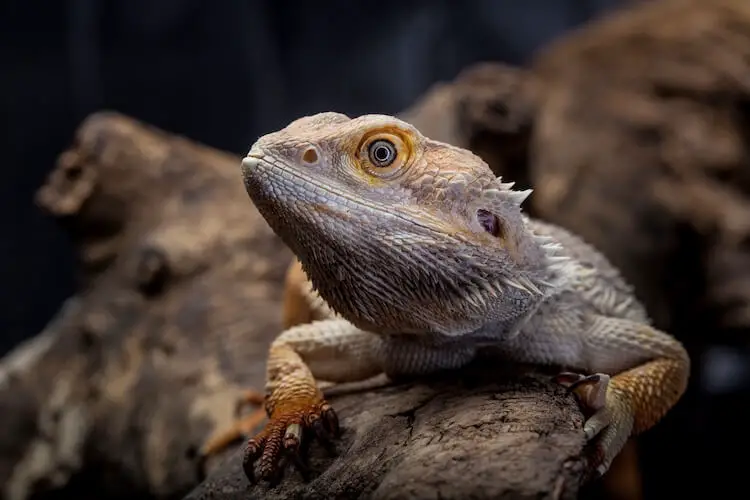
To determine the sex of a bearded dragon you are going to need to sex a bearded dragon.
Sexing a bearded dragon involves looking for the differences between males and females.
There are several ways you can sex a bearded dragon. Some of them are simple and easy for first time keepers. Others are more difficult and can stress your reptile if done wrong or at the wrong age.
Adults older than 12 months are easier to sex than juveniles. But, if you have adopted a baby there are always ways to sex a baby bearded dragon too.
If you want to learn how to sex baby and adult bearded dragons and the differences between male vs. female species, then keep reading…
How To Sex A Bearded Dragon
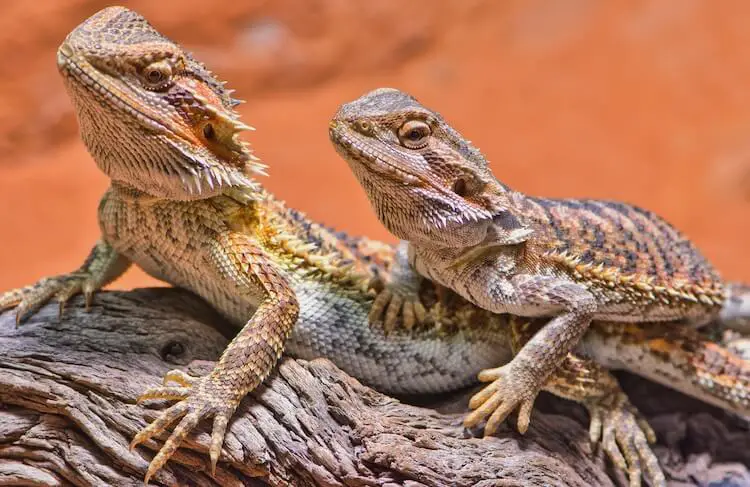
There are five different ways you can sex a bearded dragon. All of these techniques are based on observing physical body features.
As a bearded dragon ages it becomes easier to know if they are male or female. This is because they have developed these features and are easier to see. The five methods described below are focused on sexing adult bearded dragons.
Baby bearded dragons will not have fully developed these features yet. If you want to sex a baby then read chapter two as we share different methods that are more suitable for babies and juveniles.
To get the best understanding of your beardie’s gender make sure to use all five methods below.
1. Hemipenal Bulges
The fastest and easiest way to sex a beardie is by looking at their hemipenal bulges. These bulges indicate the presence of hemipenes which are internal sex organs (i.e. a reptile’s penis).
Hemipenal bulges are found on the underside of your bearded dragon next to the back of their tail. In order to look at these bulges your reptile must be comfortable being handled. If you have recently brought him home, now is not a good time to try and sex him:
- Start by holding their stomach with the palm of your hand.
- With the other hand gently hold their tail at around one third away from the base.
- Gently lift their tail upwards into an obtuse angle position. Lifting their tail will cause the side base of the tail to stretch a bit.
- Look for an outline of the hemipenal bulge.
Males have two defined grooves running vertically down the tail to the cloacal opening.
Females have one single vertical bulge above the cloacal opening in the center.. This is not as visible as a male’s and is smoother.
You must use this technique carefully. Incorrect handling and tail lifting can cause pain, injury, stress or discomfort. In the worst case scenario it can cause tail autotomy (i.e. dropping their tail).
This method will not work well for baby bearded dragons as hatchlings and juveniles do not have clear hemipenal bulges.
When using this method to sex adults it is also best to use another method for confirmation.
2. Flashlight The Hemipenal Bulges
This method is very similar to the technique above, but it involves using a flashlight. Shining a flashlight on the hemipenal bulges will make them much easier to see.
- You will need to start by handling your bearded dragon the same way you did earlier (i.e. their stomach on your flat palm).
- Gently lift their tail back over their head again.
- With your other hand shine a flash light on the upper side at the base of the tail. Aim for right where the tail meets the body.
- Looking from the back of your bearded dragon’s tail you should see the hemipenal bulges.
- The bulges will be red with dark shadows.
Males will have two red bulges. They will appear as two dark shadows next to each other on either side of the back of the tail. Females will only have one in the center.
This method is much better to sex baby individuals with as the flashlight makes small hemipenal bulges visible
3. Femoral Pores and Size
Another way you can sex a bearded dragon is by looking at the size of its femoral pores. Femoral pores are used by bearded dragons to secrete pheromones. These chemicals are secreted during breeding and social interactions.
Femoral pores are found on the underside of your beardie’s back legs on their thighs. They look like small circles running across their thighs.
Males have much larger femoral pores than females. Males’ femoral pores are also more distinct and pronounced.
There is no set way to measure the femoral pore size of males vs females as they are too small to measure. But, when eyeballing them, it is very clear to see which are larger.
Femoral pores only fully develop when a bearded dragon reaches adulthood. If your bearded dragon is still less than 12 months old you might not get accurate results using this method.
4. Cloacal Opening
The cloacal opening is also known as a vent. It is found on the underside of a bearded dragon between its rear legs and is the opening used to pass feces, urate and eggs. You will have already seen it if you have used steps one and two to sex your bearded dragon.
Males have a wider cloacal opening than females.
Keep in mind this method does not work for baby bearded dragons less than 12 weeks old. Males need to age and mature to develop a wider cloacal opening. Only then will the greater width become visible.
5. Behavior
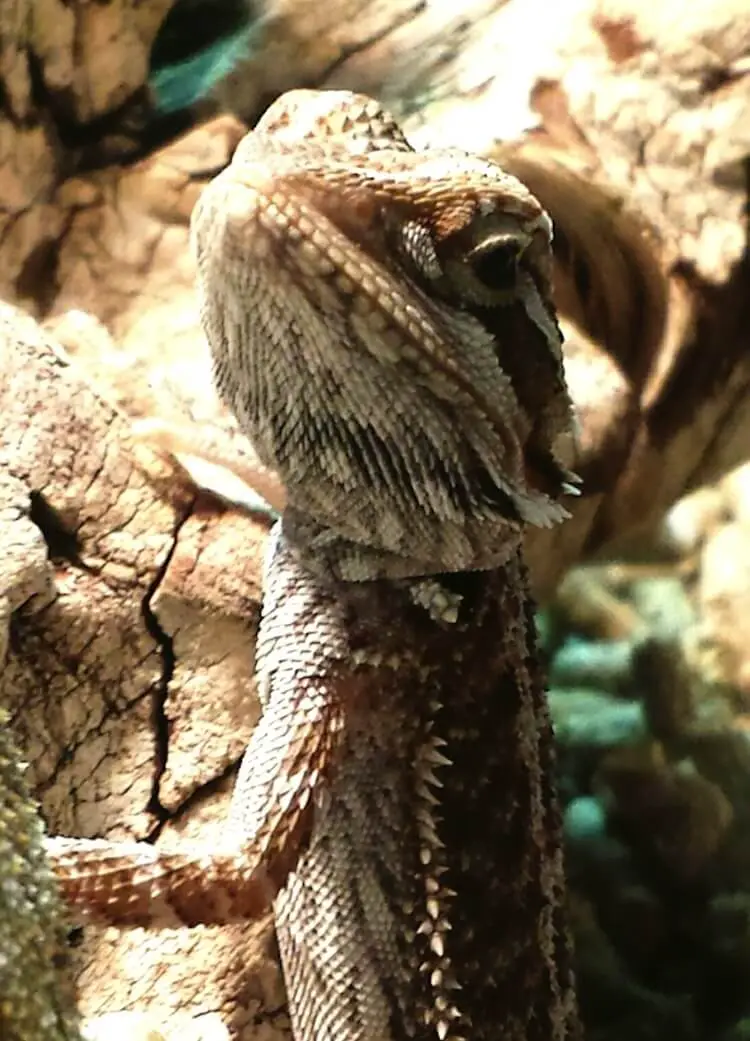
Watching for specific bearded dragon behaviors will also help you when sexing a bearded dragon. Males and females have very different behaviors.
Males show aggressive and dominant behaviors such as hissing and stamping. Males also bob their heads more and fluff their beards. Beard fluffing is used to make them seem bigger and more threatening.
Head bobbing becomes more complicated if you have two bearded dragons housed together. It can be hard to tell if one is head bobbing to initiate courtship or to show dominance over another male.
Females are more likely to show submissive behaviors rather than dominance. It is normal to see arm waving from juvenile females as a way of submitting.
Despite arm waving being more common in female juveniles, male juveniles also show submission using this behavior.
Head bobbing, beard fluffing and aggression is more common in males, but these behaviors can also be show by females. For this reason using a bearded dragon’s behavior to sex them is the least accurate method. It also needs close observation and skilled judgment.
How To Sex A Baby Bearded Dragon
Baby bearded dragons can be difficult to sex. Sexing babies and juveniles will not be as accurate as sexing adults. This is because the features used to identify their gender have not developed yet. If you want to be 100% certain about their sex then wait until they are 12 weeks old.
There are two methods that can be used to sex your baby beardie:
- Tail size
- Hemipenal bulges
Both methods should be used as an educated guess. As your reptile grows and develops sexual characteristics you can then sex them again.
Tail Size
To sex a baby bearded dragon start by using the flashlight technique described above. You can then try and confirm your guess by looking at the tail.
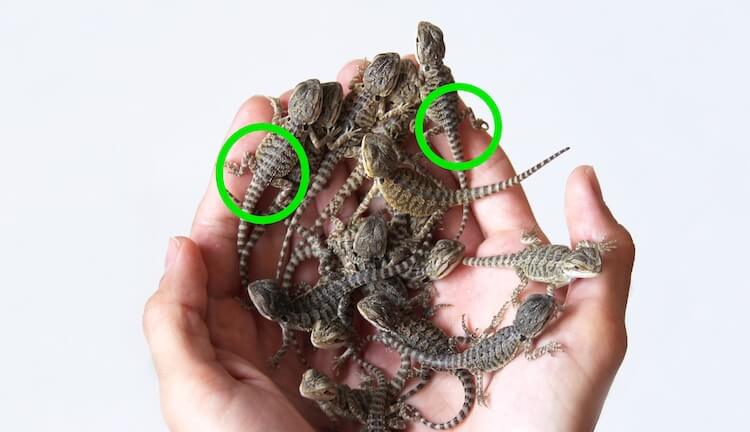
Females’ tails are narrow and taper sharply at the base. Males have slightly thicker tails towards the base. These differences become more pronounced and easier to identify as they grow.
Some people suggest you can also look at their head size. It is true males have a wider skull, but this is not easy to observe in babies so should be avoided.
What Age Can You Tell The Difference?
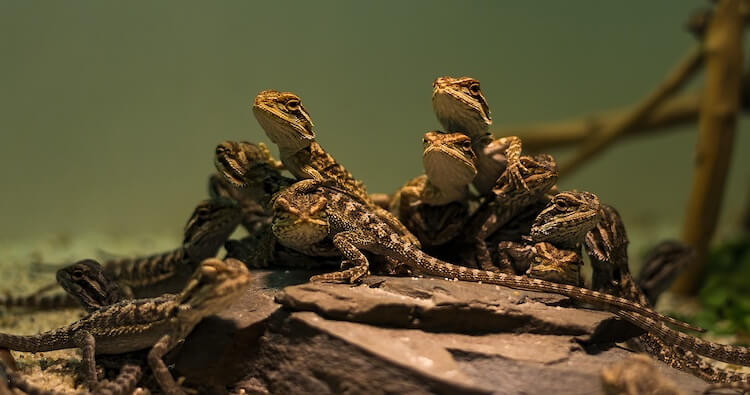
It is difficult to sex any bearded dragon younger than eight weeks old. At this age they all look very similar – no matter their gender. It will be easier and more likely that you correctly sex your bearded dragon at 8 to 12 weeks of age.
More experienced keepers and breeders might be able to sex them before eight weeks of age.
When they are young beardies can squirm and do not stay still. This makes it harder for an owner to handle them safely and sex them without hurting or damaging their tails. However as a beardie hits three months old they will begin to calm down. This makes it much easier to sex them.
If you are still unable to sex a bearded dragon at three months old, or want to be absolutely sure, you can wait until they reach 12 months old (i.e. adulthood).
A male’s hemipenal bulges, enlarged femoral pores, bigger heads, thicker tails and darker beards are easier to spot at 12 months. These sexual characteristics make it easier to spot a male or female.
Male vs. Female Bearded Dragons: What Is The Difference
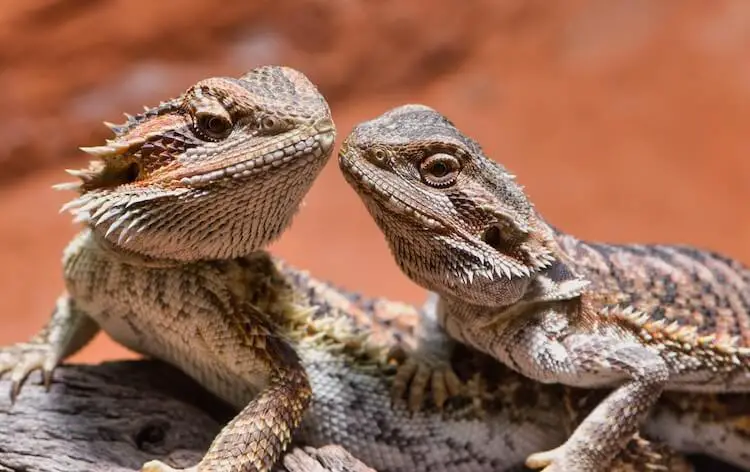
Bearded Dragons are sexually dimorphic, so the genders physically differ from each other. Males have two hemipenal bulges, enlarged femoral pores, bigger heads, thicker tails and darker beards when compared with females. All of these differences can be seen in adult individuals by using the sexing steps listed above. You may also notice differences in male vs female behaviors and the presentation of spikes.
Some of the easiest ways to spot the difference between males vs females include:
- Hemipenal bulges
- Femoral pores
- Head size
- Tail size
Head size
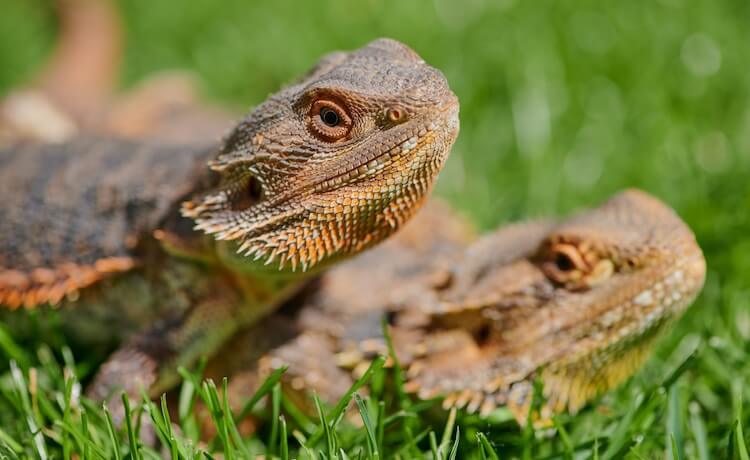
Head size and shape is different between males and females. Male bearded dragons usually have larger and thicker heads. Females have a thinner skull and smaller head.
Tail size
Males and females also have slight differences in their tails. Males have thicker tails at the base. A female’s tail is much narrower and slenderer. If you are trying to use a bearded dragon’s tail to sex them then wait until 12 months of age.
Aggressive and Submissive Behaviors
Males are more protective and can show territorial aggression. This can be seen through hissing, stamping, beard fluffing and head bobbing. Males are also more likely to have black beards. Females are more likely to show submission through arm waving – especially juveniles.
Digging is common in both males and females, but they dig for different reasons:
- Females will usually dig to make a spot to lay their eggs.
- Males will dig to prepare a spot for brumation.
It is not advisable to attempt sexing bearded dragons based on behavior alone. Behaviors are not exclusive to sexes just more frequent. It is always better to use a combination of watching and sexing your bearded dragon to identify their gender.
Spikes
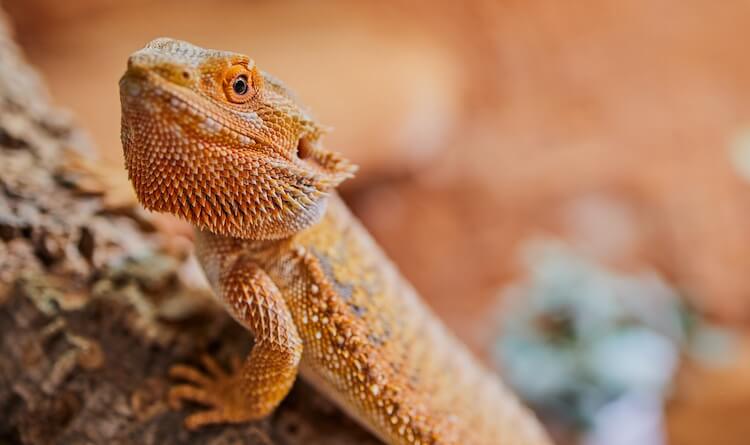
Males and females both have spikes around their beards, heads and throats. In the wild spikes are used to protect bearded dragons from predators. Bearded dragons will puff their bodies, which stiffen the spikes, creating both a more threatening appearance and defensive weapons. However, males and females use these spikes differently:
- Males present their spikes when they are ready to mate.
- Females present their spikes when they are feeling threatened. They are more likely to wave their arms when ready to mate.
Remember that to be able to identify all of the differences between males vs females requires experience. Differences between males and females are not always easy to spot and behaviors can be show by both sexes for different reasons.
Summary
Males are larger than females, have two hemipenal bulges, bigger femoral pores and heads, thicker tails and darker beards. They are also more likely to hiss, stamp, beard fluff and head bob.
Sexing a bearded dragon is important to make sure you do not house two males together. It is also fun to know the sex of your bearded dragon – especially when it comes to naming them.
Knowing their sex is also important if you need to provide gender specific care. For example you can help a female if she is trying to pass an infertile egg (it looks like yellow poop).
There are five ways you can use to sex a bearded dragon. The best method is to look for their hemipenal bulges by using a flashlight. This method also works for sexing a baby bearded dragon.
Always remember to take care when lifting their tail, and to only sex them after eight weeks of age.
Now that you know how to sex your bearded dragon, let us know their gender in the comments below.

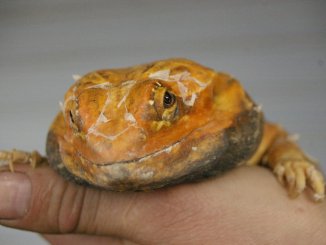
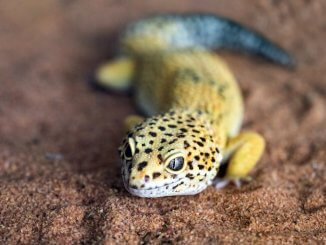
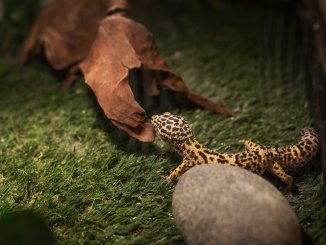

Nice to read the article, our pair is against all rules. The small one is the male and the big one is the female. Sometimes he is running around with a black beard. But sometimes she is waving.
thanks for all the information ill be checking back often, I just got 2 bearded dragons and hope to have them for many years to come
I believe I might have 2 make beardirs they are sub adult in have had them both togather as babies do I still need to seperate ibe looked at both and both look same with the bulges and ill one is just a little smaller then the other ?
Hi Peggy, since they are both males you will have to separate them. They might start to show aggressive behaviors if you don’t 🙂
Hello my name is Gina. My family and I got our first bearded dragon, in fact it our first lizard ever!😊
We are not sure of the gender yet. Read the helpful article but some behaviors are the same for both genders.
Hi Gina, glad you found the article helpful. The ones described in the article are the ways I know and have used to sex a dragon. I agree with you that behavioral characteristics are hardly a 100% accurate sexing method, therefore, when you feel confident that you can safely handle your new dragon, use the first hemipenal bulges method, which is by far the most accurate of these.
I have had beardies in the past but this time around had my best friend in the whole wide world, Roy pass away at 9.5 months =( it was a pretty rare condition not anything you would read about and the vet said there was nothing we really could’ve done as he became septic and passed on very fast. I adopted a beardie that needed overnight rehoming, knowing he would like that, and named her Aroyyahh “Rory”. Come to find out by using this article and my intimate knowledge of Roy and Aroyyah, that Roy was probably female and Aroyyahh is male! We’re keeping the names though lol. Plus, Rory is pretty gender nonspecific. Great article!
Jess we’re so sorry for your loss!
You seem very passionate about Bearded Dragons, and we hope you will be continuing this great hobby with the same passion.
You’re definitely not the first person who has given female names to male animals or vice versa. But this is part of the learning process!